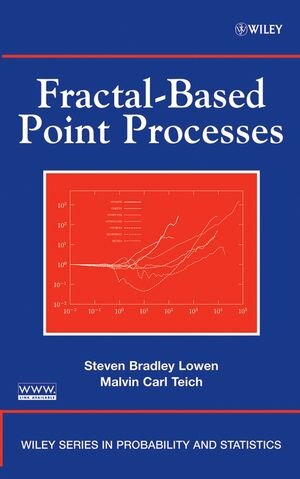
„The style of text is practical and informal with a distinctengineering approach.“ (Zentralblatt Math)
„It is apparent that the authors are truly at home in theirfield... will certainly prove valuable to scientists working inmany distinct fields.“ (Journal of the American StatisticalAssociation, March 2007)
„... an excellent exposition of a cutting-edge topic, and will beextremely valuable as a textbook and for scientists in diversefields, including astronomy.“ (Technometrics, February2007)
„... a very well-written monograph on its subject...“(Computing Reviews. com, August 10, 2006)
„.... a valuable resource and a quarry of many concreteresults from real life.“ (Mathematical Reviews, 2006f)
An integrated approach to fractals and point processes
This publication provides a complete and integrated presentation ofthe fields of fractals and point processes, from definitions andmeasures to analysis and estimation. The authors skillfullydemonstrate how fractal-based point processes, established as theintersection of these two fields, are tremendously useful forrepresenting and describing a wide variety of diverse phenomena inthe physical and biological sciences. Topics range frominformation-packet arrivals on a computer network toaction-potential occurrences in a neural preparation.
The authors begin with concrete and key examples of fractals andpoint processes, followed by an introduction to fractals and chaos. Point processes are defined, and a collection of characterizingmeasures are presented. With the concepts of fractals and pointprocesses thoroughly explored, the authors move on to integrate thetwo fields of study. Mathematical formulations for severalimportant fractal-based point-process families are provided, aswell as an explanation of how various operations modify suchprocesses. The authors also examine analysis and estimationtechniques suitable for these processes. Finally, computer networktraffic, an important application used to illustrate the variousapproaches and models set forth in earlier chapters, isdiscussed.
Throughout the presentation, readers are exposed to a number ofimportant applications that are examined with the aid of a set ofpoint processes drawn from biological signals and computer networktraffic. Problems are provided at the end of each chapter allowingreaders to put their newfound knowledge into practice, and allsolutions are provided in an appendix. An accompanying Web sitefeatures links to supplementary materials and tools to assist withdata analysis and simulation.
With its focus on applications and numerous solved problem sets, this is an excellent graduate-level text for courses in suchdiverse fields as statistics, physics, engineering, computerscience, psychology, and neuroscience.
This publication provides a complete and integrated presentation ofthe fields of fractals and point processes, from definitions andmeasures to analysis and estimation. The authors skillfullydemonstrate how fractal-based point processes, established as theintersection of these two fields, are tremendously useful forrepresenting and describing a wide variety of diverse phenomena inthe physical and biological sciences. Topics range frominformation-packet arrivals on a computer network toaction-potential occurrences in a neural preparation.
The authors begin with concrete and key examples of fractals andpoint processes, followed by an introduction to fractals and chaos. Point processes are defined, and a collection of characterizingmeasures are presented. With the concepts of fractals and pointprocesses thoroughly explored, the authors move on to integrate thetwo fields of study. Mathematical formulations for severalimportant fractal-based point-process families are provided, aswell as an explanation of how various operations modify suchprocesses. The authors also examine analysis and estimationtechniques suitable for these processes. Finally, computer networktraffic, an important application used to illustrate the variousapproaches and models set forth in earlier chapters, isdiscussed.
Throughout the presentation, readers are exposed to a number ofimportant applications that are examined with the aid of a set ofpoint processes drawn from biological signals and computer networktraffic. Problems are provided at the end of each chapter allowingreaders to put their newfound knowledge into practice, and allsolutions are provided in an appendix. An accompanying Web sitefeatures links to supplementary materials and tools to assist withdata analysis and simulation.
With its focus on applications and numerous solved problem sets, this is an excellent graduate-level text for courses in suchdiverse fields as statistics, physics, engineering, computerscience, psychology, and neuroscience.






